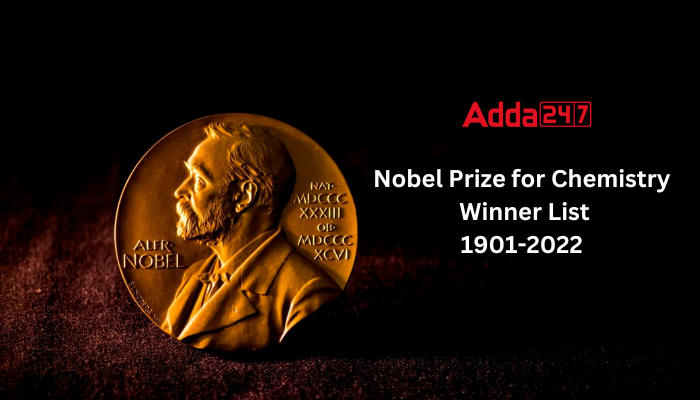The Nobel Prize for Chemistry is awarded by the Royal Swedish Academy of Sciences in Stockholm. The Nobel prize for chemistry is one of the six categories of prizes according to the will of Swedish Inventor and industrialist Alfred Bernhard Nobel. The award is given “to those who, during the preceding year, shall have conferred the greatest benefits on mankind” in the field of Chemistry.
Nobel Prize 2022 Winners list: Complete List of Noble Prize Winners Names of 2022
The first Nobel prize in chemistry was awarded to Jacobus Henricus van’t Hoff for achieving the laws of chemistry dynamics and osmotic pressure in 1901. In 2022, the Nobel prize for Chemistry was awarded to three laureates for the development of click chemistry and bioorthogonal chemistry, to Carolyn R. Bertozzi, Morten P. Medal, and K. Barry Sharpless.
Noble Prize in Chemistry 2022
List of Nobel Prize for Chemistry
| Year | Laureates | Achievements |
| 1901 | Jacobus Henricus van ‘t Hoff | For laws of chemical dynamics and osmotic pressure |
| 1902 | Emil Fischer | For work on sugar and purine syntheses |
| 1903 | Svante Arrhenius | For the theory of electrolytic dissociation |
| 1904 | Sir William Ramsay | For the discovery of inert gas elements and their places in the periodic system |
| 1905 | Adolf von Baeyer | For work on organic dyes, hydroaromatic compounds |
| 1906 | Henri Moissan | For the isolation of fluorine; the introduction of Moissan furnace |
| 1907 | Eduard Buchner | For the discovery of noncellular fermentation |
| 1908 | Ernest Rutherford | For investigations into the disintegration of elements and the chemistry of radioactive substances |
| 1909 | Wilhelm Ostwald | For pioneer work on catalysis, chemical equilibrium, and reaction velocities |
| 1910 | Otto Wallach | For pioneer work in alicyclic combinations |
| 1911 | Marie Curie | For the discovery of radium and polonium; the isolation of radium |
| 1912
|
Victor Grignard | For the discovery of the Grignard reagents |
| Paul Sabatier | For the method of hydrogenating organic compounds | |
| 1913 | Alfred Werner | For work on the linkage of atoms in molecules |
| 1914 | Theodore William Richards | For accurate determination of the atomic weights of numerous elements |
| 1915 | Richard Willstätter | For pioneer research in plant pigments, especially chlorophyll |
| 1918 | Fritz Haber | For the synthesis of ammonia |
| 1920 | Walther Hermann Nernst | For the work in thermochemistry |
| 1921 | Frederick Soddy | For chemistry of radioactive substances; occurrence and nature of isotopes |
| 1922 | Francis William Aston | For work with mass spectrograph; whole-number rule |
| 1923 | Fritz Pregl | method of microanalysis of organic substances |
| 1925 | Richard Zsigmondy | For elucidation of the heterogeneous nature of colloidal solutions |
| 1926 | Theodor H.E. Svedberg | For work on dispersed systems |
| 1927 | Heinrich Otto Wieland | For researches into the constitution of bile acids |
| 1928 | Adolf Windaus | For constitution of sterols and their connection with vitamins |
| 1929
|
Hans von Euler-Chelpin | For investigations in the fermentation of sugars and the enzyme action involved |
| Sir Arthur Harden | For investigations in the fermentation of sugars and the enzyme action involved | |
| 1930 | Hans Fischer | For hemin, chlorophyll research; synthesis of hemin |
| 1931
|
Friedrich Bergius | For invention and development of chemical high-pressure methods |
| Carl Bosch | For invention and development of chemical high-pressure methods | |
| 1932 | Irving Langmuir | For discoveries and investigations in surface chemistry |
| 1934 | Harold C. Urey | For discovery of heavy hydrogen |
| 1935 | Frédéric and Irène Joliot-Curie | For synthesis of new radioactive elements |
| 1936 | Peter Debye | For work on dipole moments and diffraction of X-rays and electrons in gases |
| 1937
|
Sir Norman Haworth | For research on carbohydrates and vitamin C |
| Paul Karrer | For research on carotenoids, flavins, and vitamins | |
| 1938 | Richard Kuhn (declined) | For carotenoid and vitamin research |
| 1939
|
Adolf Butenandt (declined) | For work on sexual hormones |
| Leopold Ruzicka | For work on polymethylenes and higher terpenes | |
| 1943 | Georg Charles von Hevesy | For use of isotopes as tracers in chemical research |
| 1944 | Otto Hahn | For discovery of the fission of heavy nuclei |
| 1945 | Artturi Ilmari Virtanen | For The invention of a fodder-preservation method |
| 1946
|
John Howard Northrop | For the preparation of enzymes and virus proteins in pure form |
| Wendell Meredith Stanley | ||
| James Batcheller Sumner | For the discovery of enzyme crystallization | |
| 1947 | Sir Robert Robinson | For investigation of alkaloids and other plant products |
| 1948 | Arne Tiselius | For research in electrophoresis and adsorption analysis; serum proteins |
| 1949 | William Francis Giauque | For the behavior of substances at extremely low temperatures |
| 1950
|
Kurt Alder | For the discovery and development of diene synthesis |
| Otto Paul Hermann Diels | For the discovery and development of diene synthesis | |
| 1951
|
Edwin Mattison McMillan | For the discovery of and research on transuranium elements |
| Glenn T. Seaborg | discovery of and research on transuranium elements | |
| 1952
|
A.J.P. Martin | development of partition chromatography |
| R.L.M. Synge | development of partition chromatography | |
| 1953 | Hermann Staudinger | work on macromolecules |
| 1954 | Linus Pauling | study of the nature of the chemical bond |
| 1955 | Vincent du Vigneaud | the first synthesis of a polypeptide hormone |
| 1956
|
Sir Cyril Norman Hinshelwood | work on the kinetics of chemical reactions |
| Nikolay Nikolayevich Semyonov | work on the kinetics of chemical reactions | |
| 1957 | Alexander Robertus Todd, Baron Todd | work on nucleotides and nucleotide coenzymes |
| 1958 | Frederick Sanger | determination of the structure of the insulin molecule |
| 1959 | Jaroslav Heyrovský | discovery and development of polarography |
| 1960 | Willard Frank Libby | development of radiocarbon dating |
| 1961 | Melvin Calvin | study of chemical steps that take place during photosynthesis |
| 1962
|
Sir John Cowdery Kendrew | determination of the structure of hemoproteins |
| Max Ferdinand Perutz | determination of the structure of hemoproteins | |
| 1963
|
Giulio Natta | structure and synthesis of polymers in the field of plastics |
| Karl Ziegler | structure and synthesis of polymers in the field of plastics | |
| 1964 | Dorothy Mary Crowfoot Hodgkin | determining the structure of biochemical compounds essential in combating pernicious anemia |
| 1965 | Robert Burns Woodward | synthesis of sterols, chlorophyll, and other substances |
| 1966 | Robert Sanderson Mulliken | work concerning chemical bonds and the electronic structure of molecules |
| 1967
|
Manfred Eigen | studies of extremely fast chemical reactions |
| Ronald George Wreyford Norrish | studies of extremely fast chemical reactions | |
| Sir George Porter | studies of extremely fast chemical reactions | |
| 1968 | Lars Onsager | work on the theory of the thermodynamics of irreversible processes |
| 1969
|
Sir Derek H.R. Barton | work in determining actual three-dimensional shapes of molecules |
| Odd Hassel | work in determining actual three-dimensional shapes of molecules | |
| 1970 | Luis Federico Leloir | discovery of sugar nucleotides and their role in the biosynthesis of carbohydrates |
| 1971 | Gerhard Herzberg | research in the structure of molecules |
| 1972
|
Christian B. Anfinsen | fundamental contributions to enzyme chemistry |
| Stanford Moore | fundamental contributions to enzyme chemistry | |
| William H. Stein | fundamental contributions to enzyme chemistry | |
| 1973
|
Ernst Otto Fischer | organometallic chemistry |
| Sir Geoffrey Wilkinson | organometallic chemistry | |
| 1974 | Paul J. Flory | studies of long-chain molecules |
| 1975
|
Sir John Warcup Cornforth | work in stereochemistry |
| Vladimir Prelog | work in stereochemistry | |
| 1976 | William Nunn Lipscomb, Jr. | structure of boranes |
| 1977 | Ilya Prigogine | widening the scope of thermodynamics |
| 1978 | Peter Dennis Mitchell | formulation of a theory of energy-transfer processes in biological systems |
| 1979
|
Herbert Charles Brown | introduction of compounds of boron and phosphorus in the synthesis of organic substances |
| Georg Wittig | introduction of compounds of boron and phosphorus in the synthesis of organic substances | |
| 1980
|
Paul Berg | first preparation of a hybrid DNA |
| Walter Gilbert | development of chemical and biological analyses of DNA structure | |
| Frederick Sanger | development of chemical and biological analyses of DNA structure | |
| 1981
|
Fukui Kenichi | orbital symmetry interpretation of chemical reactions |
| Roald Hoffmann | orbital symmetry interpretation of chemical reactions | |
| 1982 | Aaron Klug | determination of the structure of biological substances |
| 1983 | Henry Taube | study of electron-transfer reactions |
| 1984 | Bruce Merrifield | development of a method of polypeptide synthesis |
| 1985
|
Herbert A. Hauptman | development of a way to map the chemical structures of small molecules |
| Jerome Karle | development of a way to map the chemical structures of small molecules | |
| 1986
|
Dudley R. Herschbach | development of methods for analyzing basic chemical reactions |
| Yuan T. Lee | development of methods for analyzing basic chemical reactions | |
| John C. Polanyi | development of methods for analyzing basic chemical reactions | |
| 1987
|
Donald J. Cram | development of molecules that can link with other molecules |
| Jean-Marie Lehn | development of molecules that can link with other molecules | |
| Charles J. Pedersen | development of molecules that can link with other molecules | |
| 1988
|
Johann Deisenhofer | discovery of the structure of proteins needed in photosynthesis |
| Robert Huber | discovery of the structure of proteins needed in photosynthesis | |
| Hartmut Michel | discovery of the structure of proteins needed in photosynthesis | |
| 1989
|
Sidney Altman | discovery of certain basic properties of RNA |
| Thomas Robert Cech | discovery of certain basic properties of RNA | |
| 1990 | Elias James Corey | development of retrosynthetic analysis for the synthesis of complex molecules |
| 1991 | Richard R. Ernst | improvements in nuclear magnetic resonance spectroscopy |
| 1992 | Rudolph A. Marcus | explanation of how electrons transfer between molecules |
| 1993
|
Kary B. Mullis | the invention of techniques for gene study and manipulation |
| Michael Smith | the invention of techniques for gene study and manipulation | |
| 1994 | George A. Olah | development of techniques to study hydrocarbon molecules |
| 1995 | Paul Crutzen | explanation of processes that deplete Earth’s ozone layer |
| Mario Molina | explanation of processes that deplete Earth’s ozone layer | |
| F. Sherwood Rowland | explanation of processes that deplete Earth’s ozone layer | |
| 1996 | Robert F. Curl, Jr. | discovery of new carbon compounds called fullerenes |
| Sir Harold W. Kroto | discovery of new carbon compounds called fullerenes | |
| Richard E. Smalley | discovery of new carbon compounds called fullerenes | |
| 1997 | Paul D. Boyer | explanation of the enzymatic conversion of adenosine triphosphate |
| Jens C. Skou | discovery of sodium-potassium-activated adenosine triphosphatase | |
| John E. Walker | explanation of the enzymatic conversion of adenosine triphosphate | |
| 1998 | Walter Kohn | development of the density-functional theory |
| John A. Pople | development of computational methods in quantum chemistry | |
| 1999 | Ahmed H. Zewail | study of the transition states of chemical reactions using femtosecond spectroscopy |
| 2000 | Alan J. Heeger | discovery of plastics that conduct electricity |
| Alan G. MacDiarmid | discovery of plastics that conduct electricity | |
| Shirakawa Hideki | discovery of plastics that conduct electricity | |
| 2001 | William S. Knowles | work on chirally catalyzed hydrogenation reactions |
| Noyori Ryoji | work on chirally catalyzed hydrogenation reactions | |
| K. Barry Sharpless | work on chirally catalyzed oxidation reactions | |
| 2002 | John B. Fenn | development of techniques to identify and analyze proteins and other large molecules |
| Tanaka Koichi | development of techniques to identify and analyze proteins and other large molecules | |
| Kurt Wüthrich | development of techniques to identify and analyze proteins and other large molecules | |
| 2003 | Peter Agre | discoveries regarding water channels and ion channels in cells |
| Roderick MacKinnon | discoveries regarding water channels and ion channels in cells | |
| 2004 | Aaron Ciechanover | discovery of ubiquitin-mediated protein degradation |
| Avram Hershko | discovery of ubiquitin-mediated protein degradation | |
| Irwin Rose | discovery of ubiquitin-mediated protein degradation | |
| 2005 | Yves Chauvin | development of the metathesis method in organic synthesis |
| Robert H. Grubbs | development of the metathesis method in organic synthesis | |
| Richard R. Schrock | development of the metathesis method in organic synthesis | |
| 2006 | Roger D. Kornberg | work concerning the molecular basis of eukaryotic transcription |
| 2007 | Gerhard Ertl | studies of chemical processes on solid surfaces |
| 2008 | Martin Chalfie | discovery and development of the green fluorescent protein, GFP |
| Osamu Shimomura | discovery and development of the green fluorescent protein, GFP | |
| Roger Y. Tsien | discovery and development of the green fluorescent protein, GFP | |
| 2009 | Venkatraman Ramakrishnan | studies of the structure and function of the ribosome |
| Thomas Steitz | studies of the structure and function of the ribosome | |
| Ada Yonath | studies of the structure and function of the ribosome | |
| 2010 | Richard F. Heck | development of techniques to synthesize complex carbon molecules |
| Negishi Ei-ichi | development of techniques to synthesize complex carbon molecules | |
| Suzuki Akira | development of techniques to synthesize complex carbon molecules | |
| 2011 | Daniel Shechtman | discovery of quasicrystals |
| 2012 | Brian K. Kobilka | studies of G-protein-coupled receptors |
| Robert J. Lefkowitz | studies of G-protein-coupled receptors | |
| 2013 | Martin Karplus | development of multiscale models for complex chemical systems |
| Michael Levitt | development of multiscale models for complex chemical systems | |
| Arieh Warshel | development of multiscale models for complex chemical systems | |
| 2014 | Eric Betzig | development of super-resolved fluorescence microscopy |
| Stefan W. Hell | development of super-resolved fluorescence microscopy | |
| William E. Moerner | development of super-resolved fluorescence microscopy | |
| 2015 | Tomas Lindahl | mechanistic studies of DNA repair |
| Paul Modrich | mechanistic studies of DNA repair | |
| Aziz Sancar | mechanistic studies of DNA repair | |
| 2016 | Jean-Pierre Sauvage | design and synthesis of molecular machines |
| J. Fraser Stoddart | design and synthesis of molecular machines | |
| Bernard Feringa | design and synthesis of molecular machines | |
| 2017 | Jacques Dubochet | development of cryo-electron microscopy for the high-resolution structure determination of biomolecules in solution |
| Joachim Frank | development of cryo-electron microscopy for the high-resolution structure determination of biomolecules in solution | |
| Richard Henderson | development of cryo-electron microscopy for the high-resolution structure determination of biomolecules in solution | |
| 2018 | Frances Arnold | first directed evolution of enzymes |
| George P. Smith | development of phage display, a method in which a bacteriophage can be used to evolve new proteins | |
| Gregory P. Winter | work using the phage display method for the directed evolution of antibodies | |
| 2019 | John B. Goodenough | development of lithium-ion batteries |
| M. Stanley Whittingham | development of lithium-ion batteries | |
| Yoshino Akira | development of lithium-ion batteries | |
| 2020 | Emmanuelle Charpentier | development of a method for genome editing |
| Jennifer Doudna | development of a method for genome editing | |
| 2021 | Benjamin List | development of asymmetric organocatalysis |
|
|
David W.C. MacMillan | development of asymmetric organocatalysis |
| 2022 | Carolyn R. Bertozzi | development of click chemistry and bioorthogonal chemistry |
| Morten P. Meldal | development of click chemistry and bioorthogonal chemistry | |
| K. Barry Sharpless | development of click chemistry and bioorthogonal chemistry |



 Paris Olympics 2024 Medal Tally, India M...
Paris Olympics 2024 Medal Tally, India M...
 Which District of Madhya Pradesh is Famo...
Which District of Madhya Pradesh is Famo...
 EC Signs Electoral Cooperation Pact with...
EC Signs Electoral Cooperation Pact with...

